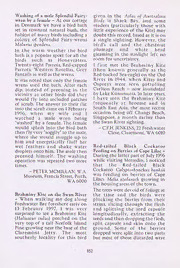
From Field and Study: Red-tailed Black Cockatoo Feeding on Berries of Cape Lilac PDF
Preview From Field and Study: Red-tailed Black Cockatoo Feeding on Berries of Cape Lilac
Washing of a male Splendid Fairy- given in the Atlas of Australian wren by a female - At our cottage Birds is Shark Bay, and some in Denmark vve have a bird bath readers (particularly those with set in remnant natural bush, the little experience of the Kite) may habitat of many birds including a doubt this record, based as it is on colony of Splendid Fairy-wrens a single sighting. However, the Malurus spendens. bird’s call and the chestnut In the warm weather the bird plumage and white head bath is a popular sport for all the gleaming in the sunlight left no birds such as Honeyeaters, room for uncertainty. Twenty-eight Parrots. Red-capped I first met the Brahminy Kite Parrots, Western Rosellas, Grey (then known generally as the Fantails as well as the wrens. Red-backed Sea-eagle) on the Ord It was noted that only the female River in 1944, when Kites and wrens used the bath. After each Ospreys were seen patrolling dip, instead of preening in the Carlton Reach - now inundated vicinity as other birds did they by Lake Kununurra. In later years, would fly into secluded patches 1 have seen the Brahminy Kite of scrub. The answer to their flit frequently at Broome and in into the scrub came on 1 February South East Asia, the most recent 1996, when my wife and I occasion being off Changi Beach, watched a male wren being Singapore, a month earlier than “washed” by a female. The female the Swan River sighting. would splash into the bird bath - C.F.H. JENKINS, 22 Freshwater then fly very "soggily” to the male, Close, Claremont, WA 6010 where she would snuggle up to him and energetically fluff her wet feathers and shake water Red-tailed Black Cockatoo droplets onto him. The male then Feeding on Berries of Cape Lilac - preened himself. The washing During the latter part of July 1996 operation was repeated two more while visiting Merredin, 1 noticed times. that the Red-tailed Black Cockatoo Calyptorhynchus banksii - PETER MCMILLAN, W.A. was feeding on berries of Cape Museum, Francis Street, Perth, Lilacs Mclia azedarach growing in WA 6000 the housing areas of the town. The trees were devoid of foliage at Brahminy Kite on the Swan River the time and the birds were - When walking my dog along plucking the berries from their Freshwater Bay foreshore early on stems, slicing through the flesh 13 February 1997, 1 was very and splitting the seed capsule surprised to see a Brahminy Kite longitudinally, extracting the (Haliastur indus) perched on the seeds and then dropping the flesh, very top of a tall Norfolk Island split capsule and skin onto the Pine growing near the base of the ground. Some of the berries Claremont Jetty. The most dropped were split into two parts southerly locality for this bird but most of those discarded were 182 still joined at the stem by the skin. flocks and groups as the day A few of the discarded berries still progresses. Conversely, towards retained a seed or two and the evening the birds again form into ground under the trees was one large flock. If this formula lit ter sd with the split and can be applied to the cockatoos in discarded berries. Merredin, then it is possible that only the same 20 birds counted During the first few weeks of may hve been frequenting August I continued to observe the Merredin. cockatoos feeding on the Cape Lilac trees and I noticed that the During my return to Merredin on cockatoos were not feeding at 16 September, 1 noticed that the random on them. They had by berries from the lowest branches now stripped the berries from the had also been stripped from the top branches of the trees and had trees and over the three days that begun to choose the berries from 1 was there, only one small group the lower branches and were in of birds was seen. the process of stripping these The seeds of the Cape Lilac berries, completely. This seemed to apply though very small, are another generally to all the Cape Lilac introduced food for this cockatoo trees. in the wheatbelt, another being the introduced Double-gee Emcx The birds had obviously been australis which in the northern feeding on the berries for some South-West Region may form up time prior to my visit and local to 99% of its diet (Blakers et al. resident Jerry Driver confirmed 1984). One wonders if the birds that the birds had been present in have been forced onto this diet the town for some time. The from introduced plants because largest number of birds in any of a shortage of natural foods. one flock was 20 but small groups of three or so were commonly One or two Port Lincoln Parrots seen. 1 was reluctant to estimate Platycercus zonarius may also feed the number of birds present in on the beries of the Cape Lilac and Merredin because observations by I have observed this both at me in south-west Jar rah Merredin in recent years and over Eucalyptus marginata forests several years at Hall’s Head, showed that the birds begin the Mandurah. day in one large flock and then -R. H. STRANGER, 28/76 East progressively split into smaller Street, Maylands 6051 183
